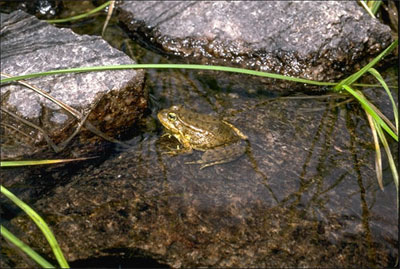Mountain Yellow-Legged Frog (Rana muscosa)

The mountain yellow-legged frog is approximately 1.5-3.5 inches in size. The dorsum is highly variable with olive, yellowish or brown color, with variation of black or brown lichen-like markings. Undersurfaces of the legs and lower belly are yellow to pale orange. They have been known to smell like garlic when handled.
This frog inhabits sunny stream banks, and undisturbed ponds and lakes, usually with gentle sloping gravel banks. Their range consists of the Sierra Nevada Mountains to the north and in the San Gabriel, San Bernardino, San Jacinto and Palomar mountains to the south, where they occur at elevations between 1,200-7,500 feet.
The mountain yellow-legged frog is believed to have been removed from approximately 99% of its’ historic range, and is currently a federally-listed endangered species. The current estimate of adult frogs is thought to be less than 200 individuals. These populations are vulnerable to extinction via recreational activities (e.g. hiking, camping, biking, fishing, photography and climbing), fires, spreading of nonnative predatory fish and amphibians (i.e. trout and bullfrogs), introduced diseases, loss of breeding pools as a result of siltation or declining of surface water, and water removal for ski operations.
Information on federally-listed threatened and endangered species can be found at the U.S. Fish and Wildlife website at http://www.fws.gov/endangered/. Information on State-listed threatened and endangered species can be found at the California Department of Fish and Game website at https://fgc.ca.gov/CESA.